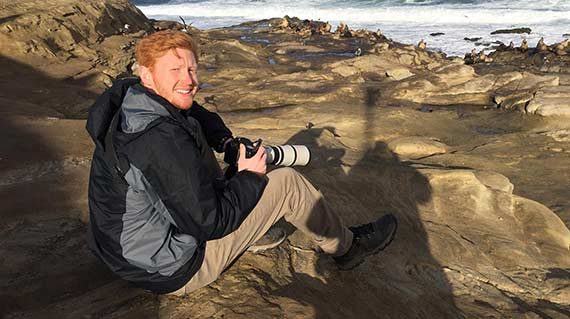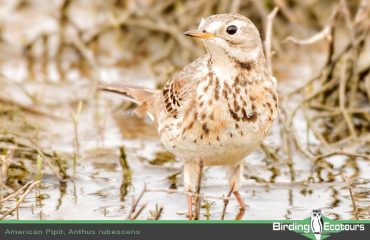
Your Guide: Jacob Roalef
Tours: Alaska, Arizona, California, Colorado, Florida, Maine, Minnesota, Ohio, Texas, Wyoming, Birding Ecotours (Worldwide)
This exciting tour of the Pacific Coast and Puget Sound region includes an incredible diversity of birds, wildlife, habitats, experiences, and scenic wonders. We’ll spend three nights at each of our three major locations. On Mount Rainier, the highest point in Washington, we will look for White-tailed Ptarmigan, Sooty Grouse, Clark’s Nutcracker, and American Dipper. Lower habitats are good for MacGillivray’s Warbler, Olive-sided Flycatcher, and Varied Thrush.
On our day at sea with Westport Pelagics we should see literally thousands of pelagic birds including Black-footed Albatross, Fork-tailed Storm-Petrel, Rhinoceros Auklet, Long-tailed Jaeger, and Pink-footed Shearwater. One of our past tours yielded point-blank looks at a Red-legged Kittiwake, an incredible rarity anywhere outside of Alaska. Tokeland is a good spot to look for Bar-tailed Godwit, while Ocean Shores may yield Pacific Golden-Plover, Buff-breasted Sandpiper, and several species of loon.
We’ll look for Mountain Quail near Belfair State Park, then spend time at Hurricane Ridge for Townsend’s Solitaire and a nice variety of raptors. Dungeness Spit is great for aquatic species: in past years we’ve found Yellow-billed Loon and Horned Puffin among scores of more common species. We are likely to find dozens of Harlequin Ducks at Ediz Hook, plus Black Oystercatchers, Marbled Murrelets, and a Peregrine Falcon or two.
We will take a maximum of seven participants. On rare occasion we may extend the maximum to ten participants.
Duration: 11 days
Limit: 4 – 8
Date: 29 July – 07 August 2026
Start: Seattle, WA
End: Seattle, WA
Price:
US$5,883 per person sharing assuming 4 – 8 participants
Single supplement: US$1250
We can run the same trip at a price similar to the larger group price for 2 tour participants, if they rent their own vehicle and pay for fuel – please e-mail [email protected] for details.

Tours: Alaska, Arizona, California, Colorado, Florida, Maine, Minnesota, Ohio, Texas, Wyoming, Birding Ecotours (Worldwide)
WASHINGTON’S PACIFIC NORTHWEST:
10-19 August 2004
Top 10 lists are voted upon by the participants at the completion of each tour.
1 – White-tailed Ptarmigan – we found FOUR of these lovely birds at very close range high above Paradise on Mount Rainier.
2 – Mountain Quail – a very vocal family of 2 adults and 4 young at the Port Orchard Airport.
3 – Bar-tailed Godwit – an adult bird in almost full breeding plumage at Tokeland with 450 Marbled Godwits.
4 – California Quail – repeated close looks at 3 males and 8 young near our motel in Sequim.
5 – Prairie Falcon – the ptarmigan announced its presence when they looked up and called as the falcon passed overhead, backlit against a clear blue sky.
6 – Black-footed Albatross – many great looks during our day at sea.
7 – Tufted Puffin – one especially cooperative breeding-plumaged adult on our pelagic trip.
8 – Long-tailed Jaeger – an adult with full tail streamers, right over our boat!
9 – Sabine’s Gull – several adult birds flying and on the water during our pelagic trip.
10 – Cassin’s Auklet – these birds usually fly or dive as soon as we spot them. This one sat on the surface next to the boat for prolonged views.
Terrestrial highlights included a quick look at a Black Bear, many Elk and Mule Deer, close views of Hoary Marmot, and lots of Golden Mantled Ground Squirrels, including the ones that joined our picnic. Banana Slugs and Mound-building Ants are always intriguing. At sea we saw Dall’s and Harbor Porpoises, Northern Fur and Elephant Seals, Blue Sharks, and the bizarre Ocean Sunfish. We had excellent looks at a male Elephant Seal from shore at Dungeness NWR.
 White-tailed Ptarmigan
White-tailed Ptarmigan
 Varied Thrush
Varied Thrush
 Black-footed Albatross
Black-footed Albatross
 Pink-footed Shearwater
Pink-footed Shearwater
 Buff-breasted Sandpiper
Buff-breasted Sandpiper
 Mountain Quail
Mountain Quail
 Townsend's Solitaire
Townsend's Solitaire
 Harlequin Duck
Harlequin Duck
 Black Oystercatcher
Black Oystercatcher
 American Pipit
American Pipit
 Gray-crowned Rosy-Finch
Gray-crowned Rosy-Finch
 Mountain Chickadee
Mountain Chickadee
 Wandering Tattler
Wandering Tattler
 Brandt's Cormorant
Brandt's Cormorant
 Black Turnstone
Black Turnstone
 Pigeon Guillemot
Pigeon Guillemot
 Western Gull
Western Gull
 Heermann's Gull
Heermann's Gull
 California Gull
California Gull
 Common Murre
Common Murre
 Tufted Puffin
Tufted Puffin
 Lapland Longspur
Lapland Longspur
 California Quail
California Quail
 Black-throated Gray Warbler
Black-throated Gray Warbler
 Bewick's Wren
Bewick's Wren
 Canada Jay
Canada Jay